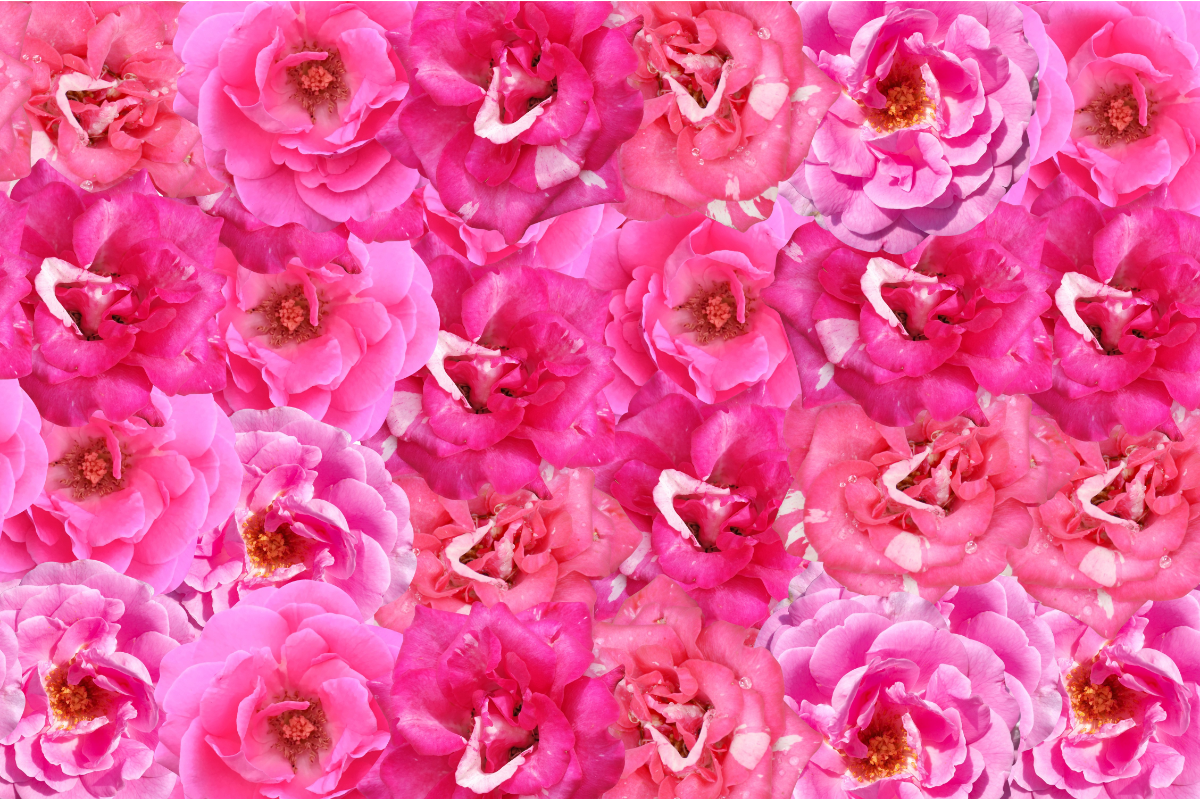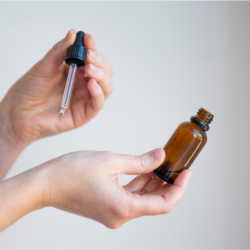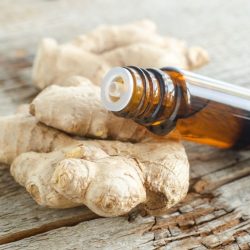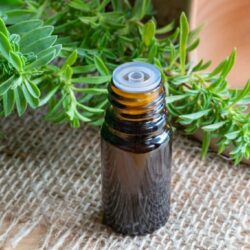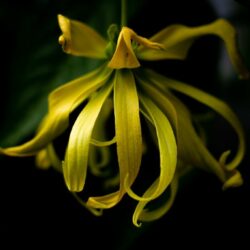Damask Rose essential oil, extracted from the famous Rosa damascena, a leading member of the Rosaceae family, has stood at the top of the floral hierarchy for thousands of years. Carefully distilled from the flowers, this precious essence has stood the test of time, arousing admiration and respect across civilisations.
From the hanging gardens of Babylon to the lush fields of modern-day Bulgaria, the rose has always been synonymous with majesty and divinity. Its origins, steeped in the depths of history, date back over 5,000 years to China, but it was in Persia and on the Greek island of Rhodes that the rose truly began its legendary journey.
This flower, which archaeologists describe as the oldest known to mankind, developed mainly in two fertile basins: Persia, the birthplace of the first essential rose oil by the physician Avicenna, and China. With the expansion of the Persian Empire as far as Damascus, rose growing flourished there, leaving an indelible mark on the city and its surroundings.
It’s not just its history that intrigues, but also its many uses, from aromatherapy to medicinal preparations, as well as its use in royal and religious rituals. The Damask rose does more than simply enchant with its fragrance; it has left its mark on medicine, gastronomy and even politics, from Antiquity to the present day.
This article reveals the secrets of Damask Rose essential oil, exploring its fascinating history, mythical origins and many applications that transcend time and culture.
History of the rose
The rose has been appreciated since ancient times, when it was considered the queen of flowers. It is revered in sacred books, and its fragrance is reserved for kings, temples and divinities.
Its origins
Wild roses have been cultivated in China since 5000 BC. The island of Rhodes(rhodon = rose in Greek) bears witness to the presence of wild roses on this island.
The oldest flower known to mankind, the rose is thought to have originated in Persia. Archaeologists say it developed in two basins: Persia, where the physician Avicenna is said to have developed the first essential rose oil, and China. As Persia gradually extended its empire to Damascus, rose cultivation spread and prospered. Some botanists claim that prolific roses are all descended from an early wild rose, Rosa canina, whose delicate flowers have five petals like thewild rose, which blooms spontaneously everywhere in our countryside.
In the Middle Ages, during the Crusades, French knights went to Damascus and brought back the Syrian rose. Knight Robert de Brie is credited with bringing Rosa damascena back to the town of Provins on his return from the crusades around 1254. Provins then became the capital of the French rose and the town made a fortune in the 13th century, spreading the rose throughout France and the West. The town’s emblematic rose is Rosa gallica officinalis, nicknamed the “apothecary’s rose”. At that time, roses were already being used in the preparation of ointments and skin remedies.
The rose, the emblem of the Gallic city, was nicknamed the “apothecary’s rose”. By this time, roses were already being used in the preparation of skin ointments and medicines. In 1610, Bulgaria became and remained the main producer of rose essence (town of Kazanlik), then under Ottoman domination. The country became the leading producer of Damask roses. At the end of the 19th century, Bulgarian plants and techniques were transported to the Burdur and Isparta regions in Anatolia, making Turkey the second-largest producer of Damask rose perfume. From 1800, cultivation began in Europe, Algeria and Asia Minor.
Its uses
The rose is revered in sacred books, and its fragrance is reserved for kings, temples and gods. Several intact bouquets of roses were found in the sarcophagus of All Ankh Amon, deposited by his wife Queen Ankh Amon more than 3,000 years ago. The rose is the oldest flower known to man and comes from Persia. Archaeologists say it developed in two basins: Persia, where Dr Avicenna is said to have developed the first essential rose oil, and China. Persia gradually extended its empire as far as Damascus, where rose cultivation spread and flourished.
Hippocrates, Celsus and Dioscorides used “rose oil” for therapeutic purposes.Oleum rhodium” was used in massages for stomach and intestinal complaints, ulcers, earaches and toothaches: a veritable panacea…!
In the Middle Ages, Avicenna prescribed an astringent rose syrup for biliary disorders. In the 9th century, “rose water” appeared, used by guests as a finger rinse before the introduction of the fork… In the fifteenth century, P Schöffer recommended “rose sugar” to heal “skinned intestines”. In the 16th century, Mattioli claimed that rose was a blessed medicine. Baumé recommended “Miel rosat” or “Rhodomel” as a detersive and astringent” used in gargles and enemas to “strengthen the stomach and tighten the intestines”.
In Greek medicine, Dioscorides (1st century) recommendedrose essential oil to relieve the pain of wounds and to strengthen the mind. In Arabic medicine, Ibn al-Baytar (13th century) recalled thatrose essential oil is obtained by maceration in sesame or olive oil. In the Middle Ages, Persia mastered the cultivation of roses.
Applied topically, this oil soothes pain in the brain and ears, as well as in abscesses and brain tumours. It also heals external ulcers. As an enema, it is beneficial for intestinal and rectal ulcers. Mixed with dill, the oil is useful against poisons, as it induces vomiting.
Bulgaria has been the leading producer of the bewitchingly fragrant essential oil obtained by distillation since the early 17th century.
In the 17th century, rose cultivation spread to the Kazanlik region of Bulgaria, which was under Ottoman domination at the time. The country became the leading producer of the damask rose. At the end of the 19th century, Bulgarian plants and techniques were repatriated to the Burdur and Isparta regions of Anatolia, making Turkey the second-largest producer of Damask rose perfume.
The Damask rose still grows wild in Syria and the Caucasus.
What are the pharmacological properties of Damask Rose essential oil?
Antimicrobial effect :
Damask rose essential oil reduces the multiple resistance ofEnterobacter aerogenes, Escherichia coli, Pseudomonas aeruginosa and Acinetobacter baumannii, and significantly increases the efficacy of beta-lactam antibiotics, quinolones and chloramphenicol through its activity on efflux pumps.
It is also an antifungal agent, potentiating the effects of amphotericin B and ketoconazole on Aspergillus.
Antispasmodic effect:
Rosa damascena essential oil inhibits contractions of the ileum and dilates the bronchi through its spasmolytic effect.
Calming effect:
Rose has a tranquillising and sympatholytic effect when inhaled.
Dermatological effects :
Damask rose regenerates tissues and cells. It is also astringent, moisturising, haemostatic and regenerates dry or flaky skin.
Anti-cancer effects :
Possessing numerous anti-tumour properties, Damask rose essential oil modulates DNA synthesis and potentiates the action of anti-cancer drugs (5-FU). It is chemopreventive against cancer:
- Interesting potential in pancreatic cancer.
- Inhibits the growth of colon cancer cells and the biosynthesis of polyamines.
- Inhibits the growth of melanomas and haematomas, as well as the progression of breast cancer cells.
An immunomodulator, it also limits neutropenia and lymphopenia during cancer chemotherapy.
Other effects:
- General tonic and neurotonic
- Aphrodisiac
- Antidepressant
- Anticonvulsant
- Potentiates GABA-A activity and increases its affinity for its receptors
- Anti-allergic
- Repellent activity against insects, repellent effect against Ixodes ticks Rhipicephalus sanguineus and Amblyomma sculptum, toxicity against West Nile virus and the filariasis agent Culex pipiens
- Antihypertensive and antiarrhythmic
- Ligand for estrogen receptors with a slightly estrogenic effect
Does Damask Rose essential oil require any precautions for use?
- May cause neurotoxic effects and toxic effects on reproduction in humans.
- For adults only.
- Enzyme inhibitor, risk of drug interactions, ask your pharmacist for advice.
- Do not swallow!
- Not recommended for pregnant or breast-feeding women.
Medical literature and clinical trials:
- Haze S, Sakai K, Gozu Y. Effects of fragrance inhalation on sympathetic activity in normal adults. Jpn J Pharmacol. 2002
- Sadraei H, Asghari G, Emami S. Inhibitory effect of Rosa damascena Mill flower essential oil, geraniol and citronellol on rat ileum contraction. Res Pharm Sci. 2013
- Sadeghi Aval Shahr H, Saadat M, Kheirkhah M, Saadat E. The effect of self-aromatherapy massage of the abdomen on the primary dysmenorrhoea. J Obstet Gynaecol. 2015
- Heydari N, Abootalebi M, Jamalimoghadam N, Kasraeian M, Emamghoreishi M, Akbarzaded M. Evaluation of aromatherapy with essential oils of Rosa damascena for the management of premenstrual syndrome. Int J Gynaecol Obstet. 2018
- Brito RG, Guimarães AG, Quintans JS, Santos MR, De Sousa DP, Badaue-Passos D Jr, de Lucca W Jr, Brito FA, Barreto EO, Oliveira AP, Quintans LJ Jr. Citronellol, a monoterpene alcohol, reduces nociceptive and inflammatory activities in rodents. J Nat Med. 2012
- Brito, R. G., Dos Santos, P. L., Quintans, J. S., de Lucca Júnior, W., Araújo, A. A., Saravanan, S., … & Quintans-Júnior, L. J. (2015). Citronellol, a natural acyclic monoterpene, attenuates mechanical hyperalgesia response in mice: Evidence of the spinal cord lamina I inhibition. Chemico-Biological Interactions
- Sadraei H, Asghari G, Emami S. Inhibitory effect of Rosa damascena Mill flower essential oil, geraniol and citronellol on rat ileum contraction. Res Pharm Sci. 2013
- De Sousa DP, Gonçalves JC, Quintans-Júnior L, Cruz JS, Araújo DA, de Almeida RN. Study of anticonvulsant effect of citronellol, a monoterpene alcohol, in rodents. Neurosci Lett. 2006
- Aoshima H, Hamamoto K. Potentiation of GABAA receptors expressed in Xenopus oocytes by perfume and phytoncid. Bioscience, biotechnology, and biochemistry, 1999
- Pina LTS, Ferro JNS, Rabelo TK, Oliveira MA, Scotti L, Scotti MT, Walker CIB, Barreto EO, Quintans Júnior LJ, Guimarães AG. Alcoholic monoterpenes found in essential oil of aromatic spices reduce allergic inflammation by the modulation of inflammatory cytokines. Nat Prod Res. 2019
- Zhuang SR, Chen SL, Tsai JH, Huang CC, Wu TC, Liu WS, Tseng HC, Lee HS, Huang MC, Shane GT, Yang CH, Shen YC, Yan YY, Wang CK. Effect of citronellol and the Chinese medical herb complex on cellular immunity of cancer patients receiving chemotherapy/radiotherapy. Phytother Res. 2009
- Ferreira LL, Oliveira Filho JG, Mascarin GM, León AAP, Borges LMF. In vitro repellency of DEET and β-citronellol against the ticks Rhipicephalus sanguineus sensu lato and Amblyomma sculptum. T Vet Parasitol. 2017
- Tabari, M. A., Youssefi, M. R., Esfandiari, A., & Benelli, G. (2017). Toxicity of β-citronellol, geraniol and linalool from Pelargonium roseum essential oil against the West Nile and filariasis vector Culex pipiens (Diptera: Culicidae). Research in veterinary science

